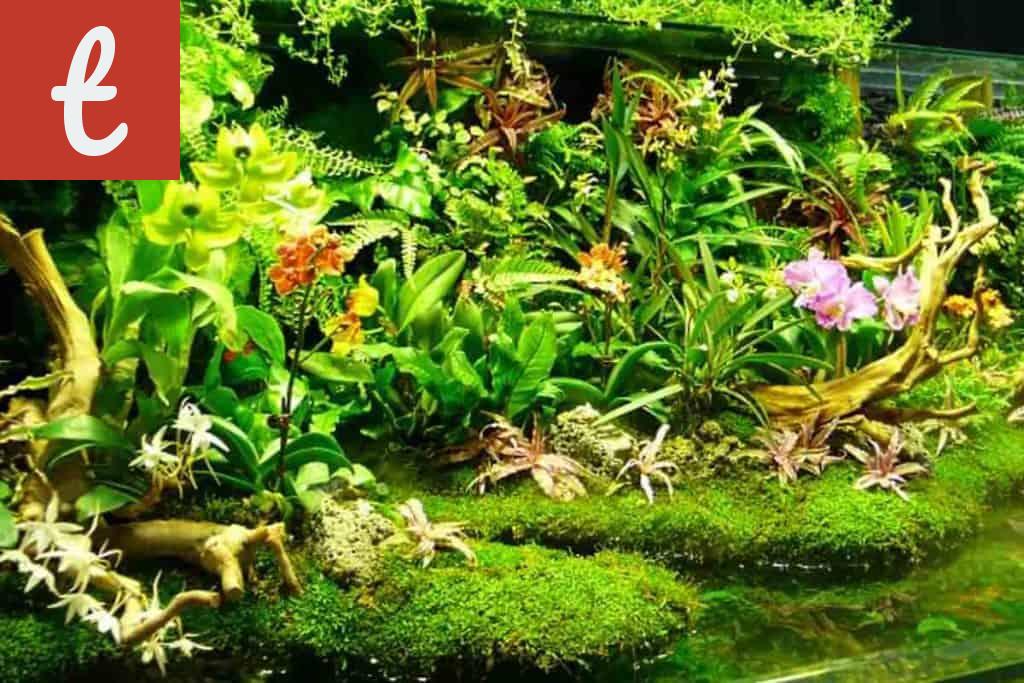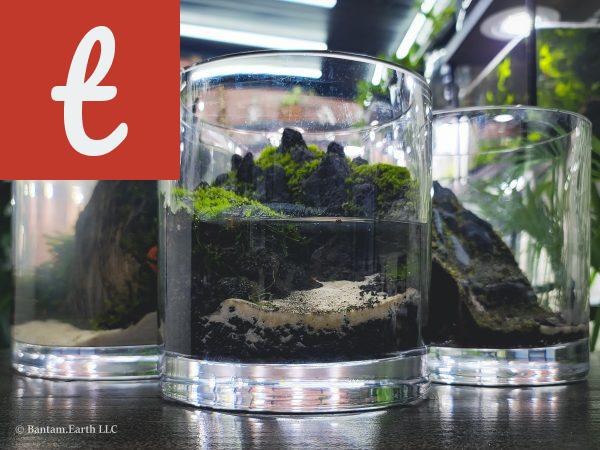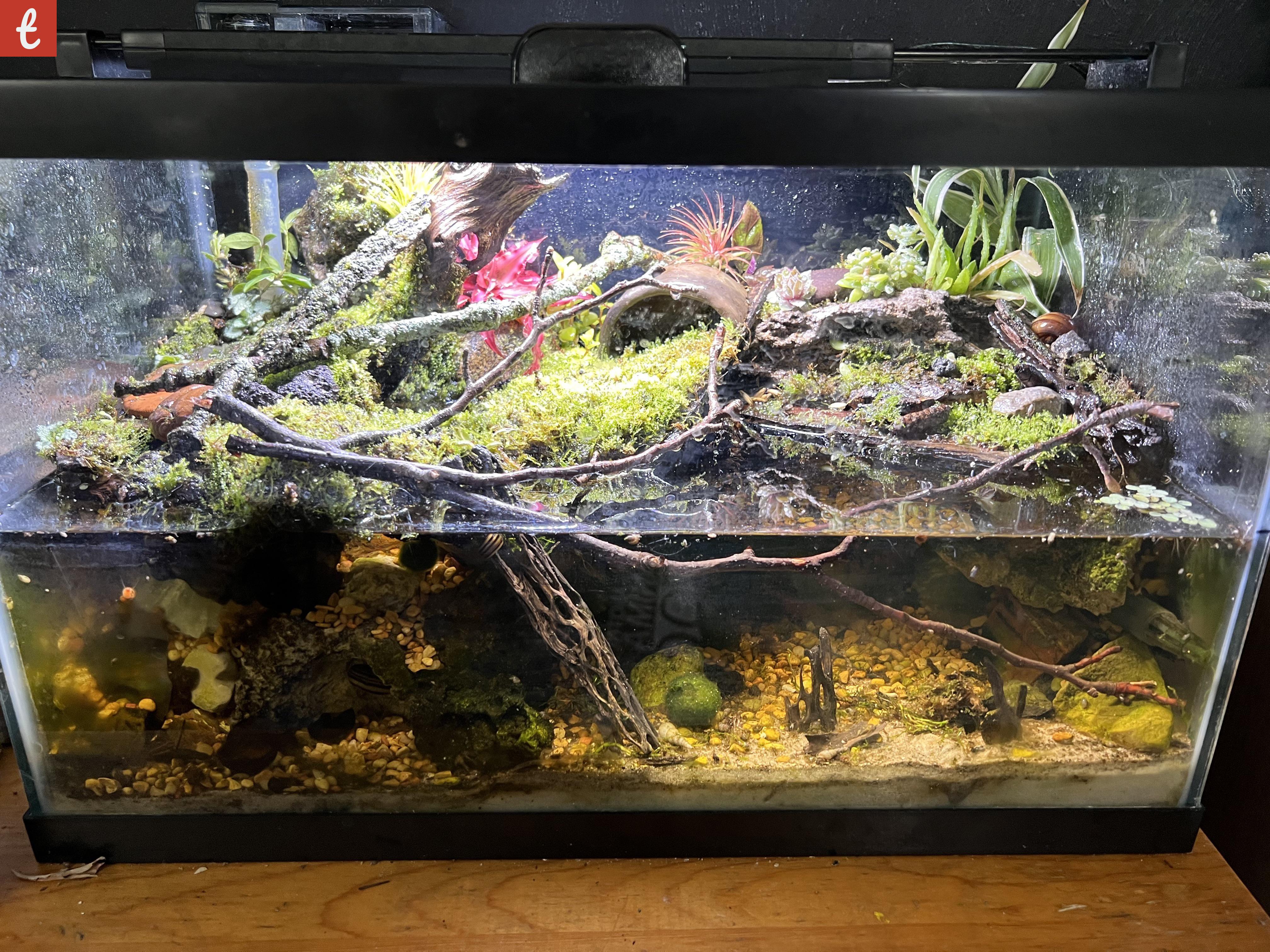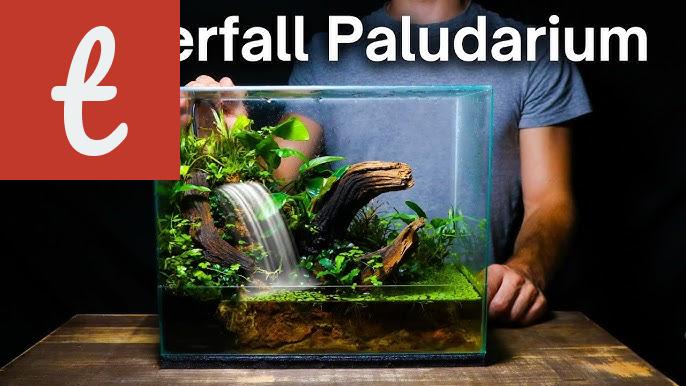Creating a Miniature Aquatic Ecosystem: The Tiniest Paludarium
Paludariums are the perfect way to incorporate both land and water in one beautiful and self-contained ecosystem. These mini aquascapes combine aquatic plants, fish, and even small land animals, bringing a slice of nature into your home or office. In this article, we will delve into the world of tiniest paludariums and how you can create your own.
When it comes to paludariums, size doesn't matter! Even the tiniest spaces can be transformed into stunning miniature aquatic ecosystems. The main challenge lies in selecting the right plants, animals, and ensuring that the environment is suitable for their survival.
- Choose the Perfect Container: Start by selecting a small, clear container that will serve as the foundation for your paludarium. A glass terrarium or a fish tank with a partition can work well for this purpose.
- Plant Selection: Look for aquatic plants that thrive in small spaces. Some popular choices include Java moss, Anubias Nana, and Marimo moss balls. These plants are resilient, low-maintenance, and add a lush green touch to your miniature ecosystem.
While choosing your plants, ensure that they are compatible with the environment you have created. Consider factors like lighting, humidity, and water temperature to successfully create an optimal habitat for your chosen flora.
- Introduce Aquatic Life: Adding a few small fish or shrimps can enhance the visual appeal of your paludarium. Make sure to research and select species that can thrive in a small space. Guppies, dwarf shrimp, and bettas are often suitable choices for these miniature environments.
- Maintaining the Ecosystem: Regularly monitor and maintain the temperature, humidity, and lighting conditions of your paludarium. Clean the glass, trim overgrown plants, and perform partial water changes to keep the ecosystem balanced and healthy.
Avoid overstocking your paludarium, as it can lead to stress and imbalance in the ecosystem. Remember, the goal is to create a harmonious environment that mimics a natural habitat.
In conclusion, creating a miniature paludarium is a delightful way to bring a slice of nature into your living space. Remember to choose the right container, carefully select compatible plants and animals, and maintain the equilibrium of your tiny ecosystem. With proper care and attention, you can enjoy the beauty and tranquility of your tiniest paludarium for years to come!
Exploring the Fascinating World of Paludariums: A Miniature Aquatic Ecosystem
Have you ever dreamt of bringing the beauty of nature right into your living space? If so, you may want to consider setting up a paludarium. A paludarium is a unique and captivating display that combines elements of both aquariums and terrariums, creating a miniature aquatic ecosystem where plants and aquatic organisms coexist harmoniously. Let's dive into the fascinating world of paludariums and discover how you can create your own mesmerizing piece of nature's wonders.
A paludarium typically consists of a glass or acrylic enclosure that is divided into two distinct areas - the aquatic section and the terrestrial section. The aquatic section is home to various aquatic plants and animals such as fish, frogs, and turtles, while the terrestrial section houses plants that thrive in a more humid environment, like mosses and ferns. This unique combination enables you to create a dynamic and visually stunning display that replicates the diverse ecosystems found in nature.
- Paludariums offer endless creative possibilities
- They provide a natural and visually appealing habitat
One of the advantages of paludariums is the versatility they offer in terms of design and plant selection. Whether you prefer a lush, tropical landscape or a serene, moss-covered habitat, you can design your paludarium to reflect your personal taste and style. The combination of aquatic and terrestrial plants creates a visually appealing display with a variety of colors, textures, and shapes. You can also incorporate driftwood, rocks, and other decorative elements to enhance the natural aesthetic of your paludarium.
Aside from their aesthetic appeal, paludariums also provide a natural and stimulating environment for the organisms living within them. Aquatic animals can swim freely in the water while terrestrial creatures can explore the dry land, giving them the opportunity to exhibit their natural behaviors and instincts. This blend of aquatic and terrestrial elements creates a dynamic ecosystem that promotes the overall well-being of the inhabitants.
Creating a paludarium requires careful attention to the needs of the plants and animals that will be housed within it. Researching the specific requirements of each species is crucial to ensure a successful and thriving ecosystem. Proper lighting, temperature regulation, water quality, and a suitable substrate are all vital components to consider when setting up your paludarium. It's important to remember that each species has its own specific requirements, so thorough planning and preparation are essential for long-term success.
In conclusion, paludariums offer a captivating glimpse into the wonders of nature and provide a unique way to bring the outdoors indoors. Whether you are a beginner or an experienced hobbyist, creating a paludarium can be a rewarding and educational endeavor. So, why not embark on this fascinating journey and discover the wonders of a miniature aquatic ecosystem in the comfort of your own home?
The Art of Building a Tiny Paludarium: A Miniature Aquatic Ecosystem
Creating a miniature aquatic ecosystem, also known as a paludarium, is a fascinating and rewarding hobby for nature enthusiasts. Combining the elements of a terrarium and an aquarium, paludariums offer a unique opportunity to observe the beauty of both aquatic and terrestrial plants and animals in a small, self-sustaining environment.
Building a paludarium requires careful planning and attention to detail. Here are the essential steps to help you create your own small-scale aquatic paradise:
- Determine the Size and Shape: Decide on the size and shape of your paludarium, keeping in mind the space you have available and the species of plants and animals you wish to house. Larger paludariums offer more flexibility in terms of plant and animal selection, but even a small one can be a captivating display.
- Choose the Right Container: Selecting the right container is crucial for the success of your paludarium. Opt for a glass or acrylic tank with a tight-fitting lid to maintain the correct humidity levels. Make sure the container has a water-tight bottom to hold the aquatic environment.
- Create a Substrate: The substrate is the foundation of your paludarium. Use a mixture of soil, sand, and aquatic planting media to provide a suitable basis for plants to grow. Ensure that the substrate is well-drained to prevent the accumulation of excess water.
- Introduce Water: Fill the bottom part of the container with water to create the aquatic habitat. The water level should be appropriate for the specific plants and animals you plan to include. It is essential to declorinate the water and adjust its pH and temperature if necessary.
- Add Aquatic Plants and Animals: Research the species of plants and animals that thrive in the conditions you've created. Choose a variety of colorful aquatic plants such as Java moss, Anubias, or Water Wisteria to enhance the aesthetic appeal. Additionally, consider adding small fish, shrimp, or snails to create a balanced ecosystem.
- Create a Land Area: Using rocks, driftwood, or specially designed platforms, create a secure land area within the container. This area will provide a spot for terrestrial plants and animals to thrive. Ensure that the land area is above the waterline to keep it dry.
- Choose Terrestrial Plants and Animals: Select suitable terrestrial plants such as ferns, bromeliads, or mosses to populate the land area. Additionally, choose small reptiles, amphibians, or insects that can comfortably live in the limited space. Research the specific requirements of each species to ensure their well-being.
- Maintain the Paludarium: Regular maintenance is essential to keep your paludarium healthy and thriving. Monitor the temperature, humidity, and lighting levels to ensure they are suitable for the inhabitants. Trim and prune plants as needed, and perform regular water changes to maintain water quality. Monitoring and balancing the ecosystem will be an ongoing task to keep it in equilibrium.
Building and maintaining a paludarium is an art that requires creativity, patience, and a deep understanding of the needs of the plants and animals involved. It offers a unique opportunity to create a captivating slice of nature within the confines of your home or office.
Whether you're a seasoned aquarist or a beginner looking to try something new, building a tiny paludarium will provide countless hours of enjoyment and a fascinating glimpse into the delicate balance of nature.

Main Title
The world of miniature aquascaping is a delightful and captivating hobby that has gained tremendous popularity in recent years. One fascinating aspect of this hobby is the creation of miniature aquatic ecosystems known as paludariums. These tiniest paludariums are a unique combination of a small aquarium and a vivarium, combining the beauty of underwater plants and fish with the lushness of land-based plants. Let's dive into the details!
Miniature aquascaping is an art form that allows enthusiasts to create stunning underwater landscapes within a limited space. While traditional aquariums focus solely on the aquatic environment, paludariums take it a step further by incorporating a land-based area, allowing for the cultivation of specific plants that thrive in both wet and dry conditions. This unique combination adds an extra layer of creativity to the hobby and opens up a world of exploration.
- List item 1: One of the main attractions of tiniest paludariums is the ability to create a fully functional ecosystem in a small space. These mini ecosystems provide a safe and stimulating environment for both aquatic and terrestrial life. It's like having a miniature version of a natural landscape right in your home.
- List item 2: Another advantage of tiniest paludariums is their versatility. With careful planning and creative design, you can recreate various biomes, from tropical rainforests to arid deserts. The possibilities are endless, and each creation becomes a unique work of art.
Creating a tiniest paludarium involves careful consideration of multiple factors, including the choice of plants, animals, and the overall design of the setup. The combination of underwater and land-based plants creates a visually stunning display, with lush greenery creeping up the sides of the enclosure and submerging into the water.
When it comes to selecting plants, it's essential to choose species that can thrive in a high humidity environment as well as partially submerged conditions. Some popular plant choices for tiniest paludariums include mosses, ferns, orchids, and bromeliads. These plants not only add beauty to the setup but also help create a natural habitat for any inhabitants.
For the aquatic section, consider small fish or aquatic invertebrates that can coexist with the chosen plants. It's crucial to find a balance between the needs of the aquatic and terrestrial organisms to ensure a healthy ecosystem.
Taking care of a tiniest paludarium requires attention to detail. Proper lighting, temperature control, and regular maintenance play a crucial role in sustaining the delicate balance of the ecosystem. It's important to keep in mind that the dimensions of these paludariums are relatively small, which means any changes in the environment can have a significant impact on its stability.
In conclusion, diving into the world of miniature aquascaping and exploring the tiniest paludariums is a rewarding and enjoyable experience. These little ecosystems bring a touch of nature into your living space, creating a serene and captivating environment for both you and the creatures that inhabit it. So why not embark on this mini-adventure and bring the wonders of the underwater and land-based world together!
Paludariums Unveiled: Discover the Wonders of a Miniature Aquatic Ecosystem
Are you looking for a unique and captivating addition to your home or office space? Look no further than a paludarium! Designed to mimic a miniature aquatic ecosystem, paludariums offer a fascinating blend of land and water that can be home to a variety of plants, fish, reptiles, and amphibians. Let's dive into the world of paludariums and explore the wonders they hold.
Paludariums are essentially a combination of a terrestrial vivarium and an aquarium, with a carefully balanced environment that supports both aquatic and terrestrial life. The name itself is derived from the Latin word "palus," meaning swamp or marsh. These ornamental enclosures typically consist of a glass or acrylic tank, divided into two or more sections - a terrestrial area and an aquatic area.
- List item 1: The terrestrial section is where various plants, such as mosses, ferns, and other moisture-loving species, can be grown. This area often features a substrate of soil or a mix of soil and sand to provide a suitable medium for the plants to root.
- List item 2: The aquatic section is where the magic happens. It is home to aquatic plants, snails, fish, and even small turtles. These creatures thrive in the water environment created within the paludarium.
What sets paludariums apart from traditional aquariums and vivariums is their ability to replicate natural habitats that combine both land and water elements. This unique setup allows for a wider range of flora and fauna to coexist, creating a visually stunning and ecologically balanced display.
Paludariums give you the opportunity to explore and recreate a variety of ecosystems, from tropical rainforests to marshes, mangroves, or even a desert oasis. These miniature habitats provide an educational experience, allowing us to observe the interactions between different species and gain a deeper understanding of the delicate balance of nature.
Proper care and maintenance are crucial to keep paludariums thriving. Light and humidity levels must be carefully regulated to support the growth of both aquatic and terrestrial plants. It's important to choose plants that are well-suited to the environmental conditions you can provide. Researching the preferred habitats and requirements of the species you wish to keep will help you create a successful paludarium.
In conclusion, paludariums are a captivating and visually appealing way to bring the wonders of nature into your living or working space. Their unique design allows for the creation of stunning miniature ecosystems that can foster a diverse range of plant and animal life. So why not dive into the world of paludariums and unlock the joys of a miniature aquatic ecosystem?




Comments on "The Tiniest Paludarium: A Miniature Aquatic Ecosystem"
No comment found!